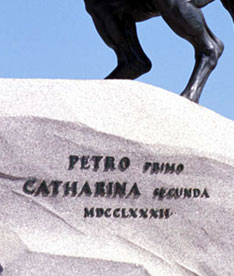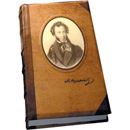Required Reading:
Pushkin, Alexander. "The Bronze Horseman" in The Bronze Horseman and Other Poems. Translated and with an introduction by D.M. Thomas. Harmondsworth: Penguin, 1992. (261 pp.) 247-257.

Images of Falconet’s statue |
This week we will read and discuss a seminal work in Russian literature, the poem the "Bronze Horseman" by the great Russian poet, Alexander Pushkin. But before we examine text, I'd like to set the scene with a few words about the dominant image of the poem, the equestrian statue of Peter I, created by the French sculptor Falconet.
The sculptor did not give his statue the name "The Bronze Horseman." This name comes from Pushkin, who wrote his poem a half century after the statue was unveiled. But it's this name that stuck, and now this monument to Peter is known as "The Bronze Horseman." Empress Catherine the Second (or Catherine the Great) commissioned the monument to honor and pay tribute to the city’s founder, Peter. Designed by the French sculptor Falconet, the statue was erected in 1782, more than 50 years after Peter's death.

PETER FIRST
CATHERINE SECOND
1782 |
SYMBOLISM OF THE MONUMENT
The monument is traditionally read as a symbol of Peter's conquest of an unruly nation. In this reading of the statue, Russia is represented by the horse rearing up on its hind legs and Peter is the monarch in control of the horse. He possesses and demonstrates the authority of the lawgiver and the command of the warrior. Underfoot, the horse is trampling a serpent, this represents Russia's victory over superstition under Peter's guidance and rule. Meanwhile, Peter looks sternly ahead, his outstretched arm gesturing westward towards Russia's future.
No less symbolic than the man on his horse is the inscription on the side of the massive granite base: it reads "To Peter I from Catherine II 1782." The inscription is given in Latin on one side and in Russian on the other. A gift often reveals quite a bit about the giver than the recipient, and this inscription is no exception. As you'll hear soon in an upcoming lecture, Catherine II, called "Catherine the Great" by nearly everyone but Professor Petrovich, had no legal claim to the Russian throne. She gained her position through a palace coup that had taken down her husband. Anxious to appear as Peter’s rightful heir, Catherine commissioned the statue, and its inscription, in order to emphasize her own place in the line of great Russian rulers.
 Alexander Pushkin (1799-1837), whom we will be learning more about in week four of this course, is considered Russia's greatest poet and the founder of modern Russian literature. He wrote "The Bronze Horseman" in 1833, although because of censorship it was not published in its entirely during Pushkin's lifetime. The flood he describes in the poem is based on historical fact; it occurred on November 7, 1824. Alexander Pushkin (1799-1837), whom we will be learning more about in week four of this course, is considered Russia's greatest poet and the founder of modern Russian literature. He wrote "The Bronze Horseman" in 1833, although because of censorship it was not published in its entirely during Pushkin's lifetime. The flood he describes in the poem is based on historical fact; it occurred on November 7, 1824.
|